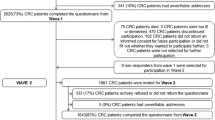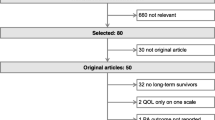Abstract
Objective
To examine the associations between physical activity and quality of life for colorectal cancer survivors; and to describe the associations of medical and sociodemographic attributes with overall quality of life, and their moderating effects on the relationships between physical activity and quality of life.
Methods
Telephone interviews were conducted with 1,996 colorectal cancer survivors recruited through the Queensland Cancer Registry. Data were collected on current quality of life; leisure-time physical activity pre- and post-diagnosis; cancer treatment and side-effects; and general sociodemographic attributes. Hierarchical generalized linear models identified variables significantly associated with quality of life.
Results
After controlling for sociodemographic variables, disease-specific variables, treatment side-effects, and pre-diagnosis leisure-time physical activity, there were significant differences in quality of life scores by post-diagnosis physical activity category. Compared to participants who were inactive after their diagnosis, those who were sufficiently active had a 17.0% higher total quality of life score. Physical activity also had a significant independent positive association with the physical well-being, functional well-being, and additional concerns subscales of the FACT-C.
Conclusions
Our findings demonstrate that quite modest changes in leisure-time physical activity are associated with quality of life. Colorectal cancer survivors may benefit from a more active lifestyle.

Similar content being viewed by others
References
Galvao D, Newton R (2005) Review of exercise intervention studies in cancer patients. J Clin Oncol 23:899–909
Knols R, Aaronson N, Uebelhart D, Fransen J, Aufdemkampe G (2005) Physical exercise in cancer patients during and after medical treatment: a systematic review of randomized and controlled clinical trials. J Clin Oncol 23:3830–3842
Oldervoll L, Kaasa S, Hjermstad M, Lund J, Loge J (2004) Physical exercise results in the improved subjective well-being of a few or is effective rehabilitation for all cancer patients? Eur J Cancer 40:951–962
Schmitz K, Holtzman J, Courneya K, Masse L, Duval S, Kane R (2005) Controlled physical activity trials in cancer survivors: a systematic review and meta-analysis. Cancer Epidem Biomar 14(7):1588–1595
Stevinson C, Lawlor D, Fox K (2004) Exercise interventions for cancer patients: systematic review of controlled trials. Cancer Cause Control 15:1035–1056
Mock V, Pickett M, Ropka M, Muscari Lin E, Stewart K, Rhodes V et al (2001) Fatigue and quality of life outcomes of exercise during cancer treatment. Cancer Pract 9(3):119–127
Segal R, Evans W, Jonhson D, Smith J, Colletta S, Gayton J et al (2001) Structured exercise improves physical functioning in women with stages I and II breast cancer: results of a randomized controlled trial. J Clin Oncol 19(3):657–665
Courneya K, Mackey J, Bell G, Jones L, Field C, Fairey A (2003) Randomized controlled trial of exercise training in postmenopausal breast cancer survivors: cardiopulonary and quality of life outcomes. J Clin Oncol 21(9):1660–1668
Daley A, Mutrie N, Crank H, Coleman R, Saxton J (2004) Exercise therapy in women who have had breast cancer: design of the Sheffield women’s exercise and well-being project. Health Ed Res 19(6):686–697
Rabin C, Pinto B, Trunzo J, Frierson G, Bucknam L (2006) Physical activity among breast cancer survivors: regular exercisers vs participants in a physical activity intervention. Psycho-oncol 15(4):344–354
Blanchard C, Baker F, Denniston M, Courneya K, Hann D, Gesme D et al (2003) Is absolute amount or change in exercise more associated with quality of life in adult cancer survivors? Prev Med 37:389–395
Blanchard C, Stein K, Baker F, Dent M, Denniston M, Courneya K et al (2004) Association between current lifestyle behaviors and health-related quality of life in breast, colorectal and prostate cancer survivors. Psychol Health 19(1):1–13
Courneya K, Friedenreich C (1997) Relationship between exercise pattern across the cancer experience and current quality of life in colorectal cancer survivors. J Altern Complem Med 3:215–226
Courneya K, Friedenreich C (1997) Relationship between exercise during treatment and current quality of life in breast cancer survivors. J Psychosoc Oncol 15:35–57
Courneya K, Friedenreich C, Arthur K, Bobick T (1999) Physical exercise and quality of life in postsurgical colorectal cancer patients. Psychol Health Med 4(2):181–187
Courneya K, Karvinen K, Campbell K, Pearcey R, Dundas G, Capstick V et al (2005) Associations among exercise, body weight, and quality of life in a population-based sample of endometrial cancer survivors. Gynecol Oncol 97:422–430
Courneya K, Keats M, Turner A (2000) Physical exercise and quality of life in cancer patients following high dose chemotherapy and autologous bone marrow transplantation. Psycho-oncol 9:127–136
Jones L, Courneya K, Vallance J, Ladha A, Mant M, Belch A et al (2004) Association between exercise and quality of life in multiple myeloma cancer survivors. Support Care Cancer 12:780–788
Pinto B, Trunzo J, Reiss P, Shiu S (2002) Exercise participation after diagnosis of breast cancer: trends and effects on mood and quality of life. Psycho-oncol 11:389–400
Vallance J, Courneya K, Jones L, Reiman T (2005) Differences in quality of life between non-Hodgkin’s lymphoma survivors meeting and not meeting public health exercise guidelines. Psycho-oncol 14:979–991
Young-McCaughan S, Sexton D (1991) A retrospective investigation of the relationship between aerobic exercise and quality of life in women with breast cancer. Oncol Nurs Forum 18(4):751–757
Bowker S, Pohar S, Johnson J (2006) A cross-sectional study of health-related quality of life deficits in individuals with comorbid diabetes and cancer. Health Qual Life Outcomes 4(17):1–9
Rogers L, Courneya K, Robbins K, Malone J, Seiz A, Koch L et al (2006) Physical activity and quality of life in head and neck cancer survivors. Support Care Cancer 14:1012–1019
Courneya K, Friedenreich C (1999) Physical exercise and quality of life following cancer diagnosis: a literature review. Ann Behav Med 21(2):171–179
Lynch BM, Baade P, Fritschi L, Leggett B, Owen N, Pakenham K et al (2007) Modes of presentation and pathways to diagnosis of colorectal cancer in Queensland. Med J Australia 186(6):288–291
Australian Institute of Health and Welfare (2003) The Active Australia Survey: A guide and manual for implementation, analysis and reporting. AIHW, Canberra
Bauman A, Armstrong T, Davies J, Owen N, Brown W, Bellew B et al (2003) Trends in physical activity participation and the impact of integrated campaigns among Australian adults, 1997–99. Aust N Z J Public Health 27(1):76–79
Department of Health and Aged Care (1999) National physical activity guidelines for Australians. Australian Government, Canberra
Ward WL, Hahn EA, Mo F, Hernandez L, Tulsky DS, Cella D (1999) Reliability and validity of the Functional Assessment of Cancer Therapy – Colorectal (FACT-C) quality of life instrument. Qual Life 8:181–195
Yost K, Cella D, Chawla A, Holmgren E, Eton D, Ayanian J et al (2005) Minimally important differences were estimated for the Functional Assessment of Cancer Therapy – Colorectal (FACT-C) instruments using a combination of distribution- and anchor-based approaches. J Clin Epidem 58:1241–1251
Hewitt M, Rowland J, Yancik R (2003) Cancer survivors in the United States: age, health, and disability. J Gerontology: Med Sci 58(1):82–91
Ball K, Owen N, Salmon J, Bauman A, Gore C (2001) Associations of physical activity with body weight and fat in men and women. Int J Obesity 25:914–919
Sallis J, Saelens B (2000) Assessment of physical activity by self-report: status, limitations, and future directions. Res Q Exerc Sport 71:1–14
Courneya K, Friedenreich C, Sela R, Quinney A, Rhodes R, Handman M (2003) The group psychotherapy and home-based physical exercise (Group-Hope) trial in cancer survivors: physical fitness and quality of life outcomes. Psycho-oncol 12:357–374
Segal R, Reid R, Courneya K, Malone S, Parliament M, Scott C et al (2003) Resistance exercise in men receiving androgen deprivation therapy for prostate cancer. J Clin Oncol 21(9):1653–1659
Acknowledgments
This study was funded by The Cancer Council Queensland.
Author information
Authors and Affiliations
Corresponding author
Rights and permissions
About this article
Cite this article
Lynch, B.M., Cerin, E., Owen, N. et al. Associations of leisure-time physical activity with quality of life in a large, population-based sample of colorectal cancer survivors. Cancer Causes Control 18, 735–742 (2007). https://doi.org/10.1007/s10552-007-9016-6
Received:
Accepted:
Published:
Issue Date:
DOI: https://doi.org/10.1007/s10552-007-9016-6




